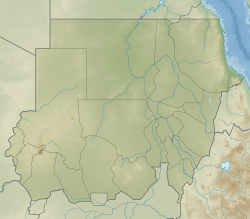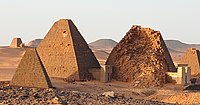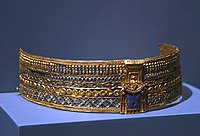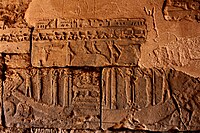Pyramids of Meroë: Difference between revisions
पाटलिपुत्र (talk | contribs) image |
→Northern cemetery: wikilink |
||
| (48 intermediate revisions by 25 users not shown) | |||
| Line 1: | Line 1: | ||
{{Infobox ancient site |
{{short description|Pyramids in Sudan}}{{Expand German}}{{Infobox ancient site |
||
|name = Pyramids of Meroë |
|name = Pyramids of Meroë |
||
|native_name = |
|native_name = |
||
|alternate_name = |
|alternate_name = |
||
|image = NubianMeroePyramids30sep2005(2).jpg |
|image = NubianMeroePyramids30sep2005(2).jpg |
||
|alt = |
|||
|caption = Pyramids of Meroë |
|caption = Pyramids of Meroë |
||
|image_size=250 |
|image_size=250 |
||
| Line 10: | Line 9: | ||
|map_alt = Location in Sudan |
|map_alt = Location in Sudan |
||
|map_size = 250px |
|map_size = 250px |
||
|map_dot_label = Pyramids of Meroë |
|||
|relief=yes |
|relief=yes |
||
|coordinates = {{coord|16|56|18|N|33|44|57|E|region:SD-04_type:landmark_source:kolossus-dewiki|display=title, inline}} |
|coordinates = {{coord|16|56|18|N|33|44|57|E|region:SD-04_type:landmark_source:kolossus-dewiki|display=title, inline}} |
||
| Line 15: | Line 15: | ||
|region = [[Nubia]] |
|region = [[Nubia]] |
||
|type = Settlement |
|type = Settlement |
||
|part_of = |
|||
|length = |
|||
|width = |
|||
|area = |
|||
|height = |
|||
|builder = |
|||
|material = |
|||
|built = |
|built = |
||
|abandoned = |
|abandoned = |
||
|cultures = Nubian ([[Kingdom of Kush]]) |
|||
|epochs = <!-- actually displays as "Periods" --> |
|||
|cultures = |
|||
|dependency_of = |
|||
|occupants = |
|||
|event = |
|||
|excavations = |
|excavations = |
||
|archaeologists = |
|archaeologists = |
||
|condition = restored |
|condition = Ruins, partly restored |
||
|ownership = |
|ownership = |
||
|management = |
|management = |
||
|public_access = |
|public_access = |
||
|website = <!-- {{URL|example.com}} --> |
|website = <!-- {{URL|example.com}} --> |
||
|notes = |
|||
}} |
}} |
||
The '''Pyramids of Meroë''' are a large number of [[Nubian pyramids]], encompassing three cemeteries near the ancient city of [[Meroë]]. The Meroë pyramids date to the later stage of the [[Kingdom of Kush]] (3rd century BCE–4th century CE) and were burial places for Kushite monarchs, other members of the royal family, and important officials and dignitaries. |
|||
[[File:Nubian pyramids in 1821.jpg|thumb|upright=1.5|Nubian [[pyramids of Meroë]] in 1821, by [[Frédéric Cailliaud]]]] |
|||
[[File:Meroe Westfriedhof.JPG|thumb|right| The West Cemetery at Meroë]] |
|||
Near [[Meroë]], three royal cemeteries were constructed.<ref>Dows Dunham (ed.); The Royal Cemeteries of Kush, volume V; 1963.</ref> |
|||
* '''South Cemetery''' features nine royal pyramids. Four of the pyramids belonged to Kings and five belonged to queens. One hundred and ninety-five other tombs complete the cemetery. |
|||
* '''North cemetery''' contains forty-one royal pyramids. Thirty belonged to kings, six to queens and five to other royals. The cemetery has three more non-royal tombs for a total of forty-four. |
|||
* '''West cemetery''' is a non-royal site. It contains some one hundred and thirteen tombs.<ref name="Reisner">G. A. Reisner, The Meroitic Kingdom of Ethiopia: A Chronological Outline, The Journal of Egyptian Archaeology, Vol. 9, No. 1/2 (Apr., 1923), pp. 34-77</ref> |
|||
The three cemeteries collectively encompass over a thousand graves, out of which at least 147 were pyramids. The majority of the pyramids (at least 82) are from the southern cemetery and were not burials of royals. |
|||
==Southern Cemetery at Begarawiyah== |
|||
[[File:Meroe Südfriedhof.JPG|thumb|right| The Southern Cemetery of Meroë]] |
|||
On 8 September 2020, the pyramids were [[2020 Sudan floods|threatened for the first time by floods]]. |
|||
The southern cemetery is the burial place of the Meroitic side of the royal family from ca 720 - 300 BCE. Towards the end the cemetery became the main royal burial site for the Kings of Meroë.<ref name="Candace"/> This cemetery contains several pyramids:<ref name="Reisner"/> |
|||
* Beg.S 1 - Queen's pyramid (anonymous) |
|||
== Pyramids and burials == |
|||
* Beg.S 2 - Queen's pyramid (anonymous) |
|||
Securely identified pyramids are marked with bold text. |
|||
* Beg.S 3 - Queen's pyramid (anonymous) |
|||
* Beg.S 4 - King's sister, King's Mother, Kenreth = Saleran? (or Saluwa?). |
|||
=== Southern cemetery === |
|||
* Beg.S 5 - King [[Amanislo]] |
|||
{{Incomplete list|date=August 2023}} |
|||
* Beg.S 6 - King [[Arqamani]] or King Khnum-ib-re(?) |
|||
* Beg.S 9 - Queen's pyramid (anonymous) |
|||
The southern cemetery was used for royal Kushite burials for the first two or three generations in the Meroitic period (270 BCE onwards).{{Sfn|Yellin|2020|p=579}} The southern cemetery includes {{Circa}} 220 burials, at least 90 of which had superstructures. Of these 90, at least 24 were pyramids.{{Sfn|Yellin|2020|p=574}} The tombs in this cemetery have been heavily pillaged.{{Sfn|Yellin|2020|p=575}} |
|||
* Beg.S 10 - King Kalka Kaltaly |
|||
* Beg. S 4 – Queen (non-ruling) [[Kanarta]]{{Sfn|Yellin|2020|p=578}} |
|||
* Beg.S 20 - Prince Weteriken (?), son of [[Amaniastabarqa]] or [[Siaspiqa]]<ref name="DM"/> |
|||
* '''Beg. S 5''' – King [[Amanislo]]{{Sfn|Eide|Hägg|Holton Pierce|Török|1996|p=568}} |
|||
* Beg.S 85 - Princess Mernua, contemp. King [[Anlamani]] - [[Aspelta]]<ref name="DM"/> |
|||
* '''Beg. S 6''' – King [[Arakamani]]{{Sfn|Eide|Hägg|Holton Pierce|Török|1996|p=566}} |
|||
* Beg.S 500 - Prince Kariben, son of King [[Siaspiqa]] or King [[Nasakhma]] <ref name="DM">Dows Dunham and M. F. Laming Macadam, Names and Relationships of the Royal Family of Napata, The Journal of Egyptian Archaeology, Vol. 35 (Dec., 1949), pp. 139-149</ref> |
|||
* '''Beg. S 10''' – Queen (non-ruling) Bartare{{Sfn|Yellin|2020|p=579}}{{Sfn|Török|2015|p=460}} (a.k.a. Karatari){{Sfn|Wolf|Riedel|2019|p=14}} |
|||
* Beg.S 503 - Queen Khennuwa, approximately time of [[Nastasen]] <ref name="Candace"/> |
|||
* Beg. S 503 – Queen (non-ruling) [[Khennuwa]]{{Sfn|Wolf|Riedel|2019|p=3}} |
|||
<gallery widths="200px" heights="200px" perrow="4"> |
|||
File:Meroe_Südfriedhof.JPG|The Southern Cemetery of Meroë |
|||
File:Meroe_Südfriedhof_(cropped).JPG|Detail of the Southern Cemetery. The large pyramids belong to Kings [[Arqamani]] and [[Amanislo]] |
|||
</gallery> |
|||
[[File:The Pyramids of Meroe.jpg|thumb|The Pyramids of Meroe]] |
|||
=== Northern cemetery === |
|||
After briefly using the southern cemetery, the northern cemetery became the main site for royal burials.{{Sfn|Yellin|2020|p=579}} The northern cemetery contains 41 known pyramids, from 30 kings, eight queens regnant, and three other individuals (crown princes?).{{Sfn|Yellin|2020|p=580}} |
|||
[[File:Meroe at sun rise, Sudan.jpg|thumb|center|upright=4|Pyramids of Meroe (North Cemetery) at sun rise]] |
|||
{{multiple image|perrow=2|total_width=230|caption_align=center |
|||
| align = right |
|||
| direction =vertical |
|||
| header=Destructions |
|||
| image1 = A great pyramid at Meroe in 1821.jpg |
|||
| image2 = Meroe N6.JPG |
|||
| footer=Great pyramid N6 , belonging to Queen [[Amanishakheto]], before and after its destruction by the treasure-hunter [[Giuseppe Ferlini]] in the 1830s }} |
|||
[[File:Nubian pyramids of Meroe in 1821.jpg|thumb|Nubian pyramids of Meroë in 1821, by [[Frédéric Cailliaud]]]] |
|||
[[File:Meroe pyramid field north.png|thumb|right|The North Cemetery]] |
|||
* '''Beg. N 1''' – Queen [[Amanitore]]{{Sfn|Eide|Hägg|Holton Pierce|Török|1998|p=903}} |
|||
* Beg. N 2 – Unidentified king, perhaps King [[Amanikhabale]]{{Sfn|Eide|Hägg|Holton Pierce|Török|1998|p=839}} |
|||
* Beg. N 3{{Sfn|Eide|Hägg|Holton Pierce|Török|1998|p=836}}<!-- presumably unidentified though could not find a source --> |
|||
* '''Beg. N 4''' – King [[Amantekha]]{{Sfn|Eide|Hägg|Holton Pierce|Török|1996|p=571}} |
|||
* Beg. N 5 – Unidentified, perhaps Prince [[Arikhankharer]]{{Sfn|Yellin|2020|p=583}} |
|||
* '''Beg. N 6''' – Queen [[Amanishakheto]]{{Sfn|Eide|Hägg|Holton Pierce|Török|1996|p=723}} |
|||
* '''Beg. N 7''' – King [[Arqamani]]{{Sfn|Eide|Hägg|Holton Pierce|Török|1996|p=589}} |
|||
* Beg. N 8 – King (...)mr(...)t,{{Sfn|Kuckertz|2021|pp=5, 11}} perhaps identical with [[Adikhalamani]]{{Sfn|Kuckertz|2021|pp=5, 11}} |
|||
* '''Beg. N 9''' – King [[Tabirqo]],{{Sfn|Kuckertz|2021|pp=5, 11}} perhaps identical with [[Adikhalamani]]{{Sfn|Török|2015|p=204}} |
|||
* Beg. N 10 – Unidentified king, unused tomb{{Sfn|Kuckertz|2021|pp=5, 12}} |
|||
* Beg. N 11 – Unidentified queen regnant,{{Sfn|Kuckertz|2021|p=12}} perhaps Queen [[Nahirqo]].{{Sfn|Kuckertz|2021|p=12}} The largest pyramid in the northern cemetery.{{Sfn|Yellin|2020|p=580}} |
|||
* Beg. N 12 – Unidentified king, perhaps King [[Tanyidamani]]{{Sfn|Eide|Hägg|Holton Pierce|Török|1996|p=664}} |
|||
* Beg. N 13 – Unidentified king, likely King [[Naqyrinsan]]{{Sfn|Eide|Hägg|Holton Pierce|Török|1996|p=685}} |
|||
* Beg. N 14 – Unidentified and destroyed, perhaps an unidentified king.{{Sfn|Chapman|1952|p=3}} |
|||
* Beg. N 15 – Unidentified and destroyed, perhaps an unidentified ruler.{{Sfn|Eide|Hägg|Holton Pierce|Török|1998|p=912}} |
|||
* Beg. N 16 – Unidentified king; this pyramid was rebuilt at a later time. Perhaps King [[Amanikhareqerem]] (original){{Sfn|Kuckertz|2021|p=5}} and King [[Aryesbokhe]] (rebuilt).{{Sfn|Kuckertz|2021|p=6}} |
|||
* '''Beg. N 17''' – King [[Amanitenmemide]]{{Sfn|Eide|Hägg|Holton Pierce|Török|1998|p=914}} |
|||
* '''Beg. N 18''' – Queen [[Amanikhatashan]]{{Sfn|Eide|Hägg|Holton Pierce|Török|1998|p=935}} |
|||
* '''Beg. N 19''' – King [[Tarekeniwal]]{{Sfn|Kuckertz|2021|p=6}} |
|||
* Beg. N 20 – Unidentified king with the [[Horus name]] ''k<sub>3</sub>-nht'',{{Sfn|Kuckertz|2021|p=14}} perhaps King [[Teriteqas]]{{Sfn|Kuckertz|2021|p=5}} |
|||
* Beg. N 21 – Unidentified ruler,{{Sfn|Kuckertz|2021|p=16}} perhaps Queen [[Shanakdakhete]]{{Sfn|Kuckertz|2021|p=16}} |
|||
* '''Beg. N 22''' – King [[Natakamani]]{{Sfn|Eide|Hägg|Holton Pierce|Török|1998|p=899}} |
|||
* Beg. N 24 – Unidentified, perhaps an unidentified king.{{Sfn|Eide|Hägg|Holton Pierce|Török|1998|p=1072}} |
|||
* Beg. N 25 – Unidentified queen regnant,{{Sfn|Kuckertz|2021|p=6}} perhaps Queen [[Amanipilade]]{{Sfn|Eide|Hägg|Holton Pierce|Török|1998|p=1074}} |
|||
* Beg. N 26 – Unidentified queen regnant,{{Sfn|Kuckertz|2021|p=6}} perhaps Queen [[Patrapeamani]]{{Sfn|Török|2015|p=206}} |
|||
* Beg. N 27 – Unidentified king, perhaps King [[Tamelerdeamani]]{{Sfn|Kuckertz|2021|p=6}} |
|||
* '''Beg. N 28''' – King [[Teqorideamani]]{{Sfn|Eide|Hägg|Holton Pierce|Török|1998|p=1072}} |
|||
* '''Beg. N 29''' – King [[Takideamani]]{{Sfn|Eide|Hägg|Holton Pierce|Török|1998|p=954}} |
|||
* Beg. N 30 – Unidentified, perhaps an unidentified king.{{Sfn|Yellin|2020|p=582}} |
|||
* Beg. N 32 – Unidentified queen regnant,{{Sfn|Kuckertz|2021|p=6}} perhaps Queen [[Amanikhalika]]{{Sfn|Yellin|2020|p=616}} |
|||
* Beg. N 34 – Unidentified king, perhaps King [[Aritenyesbokhe]]{{Sfn|Kuckertz|2021|p=6}} |
|||
* Beg. N 35 – Unidentified, perhaps an unidentified king{{Sfn|Edwards|2004|p=144}} |
|||
* Beg. N 36 – Unidentified king, perhaps King [[Amanitaraqide]]{{Sfn|Kuckertz|2021|p=6}} |
|||
* Beg. N 37 – Unidentified king, perhaps King [[(.)p(...)niñ]]{{Sfn|Török|2015|p=206}} |
|||
* Beg. N 38 – Unidentified king, perhaps King [[(...)k(...)]]{{Sfn|Török|2015|p=206}} |
|||
* Beg. N 40 – Unidentified, perhaps an unidentified king.{{Sfn|Chapman|1952|p=3}} |
|||
* Beg. N 41 – Unidentified, perhaps an unidentified king.{{Sfn|Chapman|1952|p=3}} |
|||
* Beg. N 43 – Unidentified king, perhaps King [[Amanikhedolo]]{{Sfn|Eide|Hägg|Holton Pierce|Török|1998|p=954}} |
|||
* Beg. N 51 – Unidentified king, perhaps King [[Yesebokheamani]]{{Sfn|Kuckertz|2021|p=6}} |
|||
* Beg. N 53 – Unidentified king, perhaps King [[Arnekhamani]]{{Sfn|Eide|Hägg|Holton Pierce|Török|1996|p=582}} |
|||
* Beg. N 56 – Unidentified, perhaps Prince [[Arikakahtani]]{{Sfn|Dunham|1957|p=7}} |
|||
====Treasures and artifacts of the North Cemetery==== |
|||
Numerous treasures were discovered in the pyramids since the 19th century. |
|||
<gallery widths="200px" heights="200px" perrow="4"> |
|||
File:Lamp met handvat in de vorm van een paard uit de piramide van Koningin Amanikhatashan te Meroë. MFA, Boston.jpg|Lamp with handle in the shape of a horse, from the pyramid of Queen [[Amanikhatashan]] in Meroë (c.62-c.85 CE). [[Museum of Fine Arts, Boston]] |
|||
File:Aegyptisches Museum Berlin InvNr22877 20080313 Halskette Amanishakheto 2.jpg|[[Usekh collar]] of queen [[Amanishakheto]] |
|||
File:Aegyptisches Museum Berlin InvNr22877 20080313 Schulterkragen Amanishakheto.jpg|Bracelet from the tomb of [[Amanishakheto]] |
|||
File:Aethiopen. Begerauîeh (Begrawiya). Pyramidengruppe A. Pyr. 15. Gold- und Silber- Schmuck aufgefunden von Ferlini 1830. ( jetzt im K. Museum zu Berlin.) (NYPL b14291191-44190).tiff|Some of the treasures found by Ferlini in the pyramid of queen [[Amanishakheto]] |
|||
File:Wall of Meroe Pyramid chapel Amanitenmomide Dez2005.jpg|Wall of the Pyramid chapel of [[Amanitenmemide]] |
|||
File:MeroePyramidChapelDetail.jpg|Detail of Pyramid Chapel Beg. N1 |
|||
</gallery> |
|||
=== Western cemetery === |
|||
{{Incomplete list|date=August 2023}} |
|||
[[File:Meroe Westfriedhof.JPG|thumb|right| The West Cemetery at Meroë]] |
|||
The western cemetery saw the longest continuous use, with burials dating back to the 9th century BCE. The western cemetery contains no burials of monarchs and was instead used by non-royal elites.{{Sfn|Yellin|2020|p=570}} There are over 800 graves in the western cemetery, out of which at least 82 were pyramids.{{Sfn|Yellin|2020|p=570}} |
|||
* Beg. W 19 – Prince Tedeqen{{Sfn|Yellin|2020|p=572}} |
|||
== See also == |
|||
==North Cemetery at Begarawiyah== |
|||
[[File:Meroe pyramid field north.png|thumb|right|300px|The North Cemetery]] |
|||
[[File:MeroePyramidChapelDetail.jpg|thumb|Detail of Pyramid Chapel Beg. N1]] |
|||
After the southern cemetery was full, the burials continued in the north. This site contains the royal burials of the Kings and Queens of Meroë from ca 300 BCE to about 350 AD.<ref name="Candace"/> The northern cemetery contains many royal pyramids:<ref name="Reisner"/> |
|||
* [[List of monarchs of Kush]] |
|||
* Beg. N1 - Kandake [[Amanitore]] |
|||
* [[El-Kurru#Pyramids and tombs at El-Kurru|El-Kurru pyramids]] |
|||
* Beg. N2 - King [[Amanikhabale]]<ref name="Candace">George A. Reisner, The Pyramids of Meroë and the Candaces of Ethiopia, Museum of Fine Arts Bulletin, Vol. 21, No. 124 (Apr., 1923), pp. 11-27</ref> |
|||
* [[Jebel Barkal#Pyramids|Jebel Barkal pyramids]] |
|||
* Beg. N3 - Queen's Pyramid (unidentified) |
|||
* [[Sedeinga pyramids]] |
|||
* Beg. N4 - King [[Amantekha]] |
|||
* [[Nuri#Tombs at Nuri|Nuri pyramids]] |
|||
* Beg. N5 - Prince [[Arikhankharer]], son of [[Amanitore]] |
|||
* Beg. N6 - Kandake [[Amanishakheto]] |
|||
* Beg. N7 - King [[Arqamani]] (Merqetek) |
|||
* Beg. N8 - Nahirqa(?) (Nayakhensan-mery-Isis ?). |
|||
* Beg. N9 - King [[Tabirqo]] ([[Adikhalamani]] ?) |
|||
* Beg. N10 - King [[Shorkaror]] or [[Arikhankharer]] |
|||
* Beg. N11 - Queen [[Shanakdakhete]] |
|||
* Beg. N12 - Kandake [[Shanakdakhete]] |
|||
* Beg. N13 - King [[Naqyrjinsan]]<ref>Fontes Historiae Nubiorum II, p.686</ref> |
|||
* Beg. N14 - King's Pyramid (unidentified) |
|||
* Beg. N15 - King's Pyramid (unidentified) |
|||
* Beg. N16 - King Akhyesteme? |
|||
* Beg. N17 - King [[Amanitenmemide]], Nebmaatre I |
|||
* Beg. N18 - Queen [[Amanikhatashan]] |
|||
* Beg. N19 - King [[Tarekeniwal]] |
|||
* Beg. N20 - King's Pyramid (unidentified) |
|||
* Beg. N21 - King's Pyramid (unidentified) |
|||
* Beg. N22 - King [[Natakamani]] |
|||
* Beg. N24 - King's Pyramid (unidentified) |
|||
* Beg. N25 - King's Pyramid (unidentified) |
|||
* Beg. N26 - Queen's Pyramid (unidentified) |
|||
* Beg. N27 - King's Pyramid (unidentified) |
|||
* Beg. N28 - King [[Teqerideamani I]] |
|||
* Beg. N29 - King Takizemani. |
|||
* Beg. N30 - King's Pyramid (unidentified) |
|||
* Beg. N32 - Queen's Pyramid (unidentified) |
|||
* Beg. N34 - King Artanyeszeme, Kheperkare III. |
|||
* Beg. N35 - Maniterara(ze), Teraramani. |
|||
* Beg. N36 - King's Pyramid (unidentified) |
|||
* Beg. N37 - Unknown. |
|||
* Beg. N38 - King's Pyramid (unidentified) |
|||
* Beg. N40 - King's Pyramid (unidentified) |
|||
* Beg. N41 - King's Pyramid (unidentified) |
|||
* Beg. N51 - King's Pyramid (unidentified) |
|||
* Beg. N52 - Unknown |
|||
* Beg. N53 - King's Pyramid (unidentified) |
|||
* Beg. N55 - Unknown. |
|||
* Beg. N56 - Prince's Pyramid (unidentified) |
|||
== References == |
|||
==West Cemetery at Begarawiyah== |
|||
* Beg. W14 - Nasapanasap |
|||
* Beg. W18 - Taktidamani |
|||
* Beg. W19 - Tedeqen |
|||
* Beg. W105 - Amanipilde |
|||
* Beg. W113 - King Mashadeakhel |
|||
* Beg. W342 - Atedekey |
|||
== |
=== Citations === |
||
{{Reflist|20em}} |
|||
* [[Nubian pyramids]] |
|||
=== Bibliography === |
|||
* '''The royal cemetery at [[el-Kurru]]'''. Buried here were [[Kashta]], [[Piye]], [[Tantamani]], [[Shabaka]] and several queens are buried in pyramids at El-Kurru. |
|||
* '''The royal cemetery at [[Nuri]]'''. King Taharqa and other royals form the kingdom of Napata are buried at Nuri. |
|||
* '''Pyramids of [[Jebel Barkal]]''' |
|||
* {{Cite book |last=Chapman |first=Suzanne E. |title=The Royal Cemeteries of Kush: Volume III: Decorated Chapels of the Meroitic Pyramids at Meroë and Barkal |date=1952 |publisher=The Museum of Fine Arts, Boston, Massachusetts |pages= |language=en}} |
|||
==References== |
|||
* {{Cite book |last=Dunham |first=Dows |title=The Royal Cemeteries of Kush: Volume IV: Royal Tombs at Meroë and Barkal |date=1957 |publisher=The Museum of Fine Arts, Boston, Massachusetts |pages= |language=en}} |
|||
{{Reflist}} |
|||
* {{Cite book |last=Edwards |first=David N. |url=https://books.google.com/books?id=3z-yDRgxn5MC |title=The Nubian Past: An Archaeology of the Sudan |date=2004 |publisher=Routledge |isbn=978-1-134-20087-0 |pages= |language=en}} |
|||
* {{Cite book |last1=Eide |first1=Tormod |url=https://digitalt.uib.no/handle/1956.2/3083#preview |title=Fontes Historiae Nubiorum: Textual Sources for the History of the Middle Nile Region Between the Eighth Century BC and the Sixth Century AD: Vol. II: From the Mid-Fifth to the First Century BC |last2=Hägg |first2=Tomas |last3=Holton Pierce |first3=Richard |last4=Török |first4=László |date=1996 |publisher=University of Bergen |isbn=82-91626-01-4 |language=en}} |
|||
* {{Cite book |last1=Eide |first1=Tormod |url=https://digitalt.uib.no/handle/1956.2/3083#preview |title=Fontes Historiae Nubiorum: Textual Sources for the History of the Middle Nile Region Between the Eighth Century BC and the Sixth Century AD: Vol. III: From the First to the Sixth Century AD |last2=Hägg |first2=Tomas |last3=Holton Pierce |first3=Richard |last4=Török |first4=László |date=1998 |publisher=University of Bergen |isbn=82-91626-07-3 |language=en}} |
|||
* {{Cite journal |last=Kuckertz |first=Josefine |date=2021 |title=Meroe and Egypt |url=https://escholarship.org/uc/item/6061m848 |journal=UCLA Encyclopedia of Egyptology |language=en}} |
|||
* {{Cite book |last=Török |first=László |url=https://books.google.com/books?id=Guh5DwAAQBAJ |title=The Kingdom of Kush: Handbook of the Napatan-Meroitic Civilization |date=2015 |publisher=BRILL |isbn=978-90-04-29401-1 |language=en}} |
|||
* {{Cite journal |last1=Wolf |first1=Pawel |last2=Riedel |first2=Alexandra |date=2019 |title=Meroe, Sudan. Fieldwork at the Royal Cemeteries of Meroe – A Progress report of the Qatari Mission for the Pyramids of Sudan. The years 2017 and 2018 |url=https://publications.dainst.org/journals/efb/article/view/2196 |journal=E-Forschungsberichte |language=de |pages=189–196 |doi=10.34780/ja1u-r1dj |issn=2198-7734}} |
|||
* {{Cite book |last=Yellin |first=Janice W. |url=https://books.google.com/books?id=amkLEAAAQBAJ |title=The Oxford Handbook of Ancient Nubia |date=2020 |publisher=Oxford University Press |isbn=978-0-19-049627-2 |language=en |chapter=Prolegomena to the Study of Meroitic Art}} |
|||
* {{Cite book |last=Yellin |first=Janice W. |url=https://books.google.com/books?id=-8kQEAAAQBAJ |title=The Oxford Handbook of Ancient Nubia |date=2020b |publisher=Oxford University Press |isbn=978-0-19-752183-0 |pages= |language=en |chapter=The Royal and Elite Cemeteries at Meroe}} |
|||
{{DEFAULTSORT:Pyramids of Meroe}} |
|||
[[Category:Archaeological sites in Sudan]] |
[[Category:Archaeological sites in Sudan]] |
||
[[Category:Pyramids in Sudan]] |
[[Category:Pyramids in Sudan]] |
||
Latest revision as of 23:23, 8 June 2024
You can help expand this article with text translated from the corresponding article in German. Click [show] for important translation instructions.
|
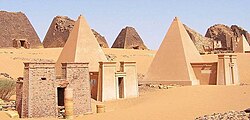 Pyramids of Meroë | |
| Standort | Northern State, Sudan |
|---|---|
| Region | Nubia |
| Coordinates | 16°56′18″N 33°44′57″E / 16.93833°N 33.74917°E |
| Typ | Settlement |
| History | |
| Cultures | Nubian (Kingdom of Kush) |
| Site notes | |
| Condition | Ruins, partly restored |
The Pyramids of Meroë are a large number of Nubian pyramids, encompassing three cemeteries near the ancient city of Meroë. The Meroë pyramids date to the later stage of the Kingdom of Kush (3rd century BCE–4th century CE) and were burial places for Kushite monarchs, other members of the royal family, and important officials and dignitaries.
The three cemeteries collectively encompass over a thousand graves, out of which at least 147 were pyramids. The majority of the pyramids (at least 82) are from the southern cemetery and were not burials of royals.
On 8 September 2020, the pyramids were threatened for the first time by floods.
Pyramids and burials
[edit]Securely identified pyramids are marked with bold text.
Southern cemetery
[edit]The southern cemetery was used for royal Kushite burials for the first two or three generations in the Meroitic period (270 BCE onwards).[1] The southern cemetery includes c. 220 burials, at least 90 of which had superstructures. Of these 90, at least 24 were pyramids.[2] The tombs in this cemetery have been heavily pillaged.[3]
- Beg. S 4 – Queen (non-ruling) Kanarta[4]
- Beg. S 5 – King Amanislo[5]
- Beg. S 6 – King Arakamani[6]
- Beg. S 10 – Queen (non-ruling) Bartare[1][7] (a.k.a. Karatari)[8]
- Beg. S 503 – Queen (non-ruling) Khennuwa[9]
-
The Southern Cemetery of Meroë

Northern cemetery
[edit]After briefly using the southern cemetery, the northern cemetery became the main site for royal burials.[1] The northern cemetery contains 41 known pyramids, from 30 kings, eight queens regnant, and three other individuals (crown princes?).[10]



- Beg. N 1 – Queen Amanitore[11]
- Beg. N 2 – Unidentified king, perhaps King Amanikhabale[12]
- Beg. N 3[13]
- Beg. N 4 – King Amantekha[14]
- Beg. N 5 – Unidentified, perhaps Prince Arikhankharer[15]
- Beg. N 6 – Queen Amanishakheto[16]
- Beg. N 7 – King Arqamani[17]
- Beg. N 8 – King (...)mr(...)t,[18] perhaps identical with Adikhalamani[18]
- Beg. N 9 – King Tabirqo,[18] perhaps identical with Adikhalamani[19]
- Beg. N 10 – Unidentified king, unused tomb[20]
- Beg. N 11 – Unidentified queen regnant,[21] perhaps Queen Nahirqo.[21] The largest pyramid in the northern cemetery.[10]
- Beg. N 12 – Unidentified king, perhaps King Tanyidamani[22]
- Beg. N 13 – Unidentified king, likely King Naqyrinsan[23]
- Beg. N 14 – Unidentified and destroyed, perhaps an unidentified king.[24]
- Beg. N 15 – Unidentified and destroyed, perhaps an unidentified ruler.[25]
- Beg. N 16 – Unidentified king; this pyramid was rebuilt at a later time. Perhaps King Amanikhareqerem (original)[26] and King Aryesbokhe (rebuilt).[27]
- Beg. N 17 – King Amanitenmemide[28]
- Beg. N 18 – Queen Amanikhatashan[29]
- Beg. N 19 – King Tarekeniwal[27]
- Beg. N 20 – Unidentified king with the Horus name k3-nht,[30] perhaps King Teriteqas[26]
- Beg. N 21 – Unidentified ruler,[31] perhaps Queen Shanakdakhete[31]
- Beg. N 22 – King Natakamani[32]
- Beg. N 24 – Unidentified, perhaps an unidentified king.[33]
- Beg. N 25 – Unidentified queen regnant,[27] perhaps Queen Amanipilade[34]
- Beg. N 26 – Unidentified queen regnant,[27] perhaps Queen Patrapeamani[35]
- Beg. N 27 – Unidentified king, perhaps King Tamelerdeamani[27]
- Beg. N 28 – King Teqorideamani[33]
- Beg. N 29 – King Takideamani[36]
- Beg. N 30 – Unidentified, perhaps an unidentified king.[37]
- Beg. N 32 – Unidentified queen regnant,[27] perhaps Queen Amanikhalika[38]
- Beg. N 34 – Unidentified king, perhaps King Aritenyesbokhe[27]
- Beg. N 35 – Unidentified, perhaps an unidentified king[39]
- Beg. N 36 – Unidentified king, perhaps King Amanitaraqide[27]
- Beg. N 37 – Unidentified king, perhaps King (.)p(...)niñ[35]
- Beg. N 38 – Unidentified king, perhaps King (...)k(...)[35]
- Beg. N 40 – Unidentified, perhaps an unidentified king.[24]
- Beg. N 41 – Unidentified, perhaps an unidentified king.[24]
- Beg. N 43 – Unidentified king, perhaps King Amanikhedolo[36]
- Beg. N 51 – Unidentified king, perhaps King Yesebokheamani[27]
- Beg. N 53 – Unidentified king, perhaps King Arnekhamani[40]
- Beg. N 56 – Unidentified, perhaps Prince Arikakahtani[41]
Treasures and artifacts of the North Cemetery
[edit]Numerous treasures were discovered in the pyramids since the 19th century.
-
Lamp with handle in the shape of a horse, from the pyramid of Queen Amanikhatashan in Meroë (c.62-c.85 CE). Museum of Fine Arts, Boston
-
Usekh collar of queen Amanishakheto
-
Bracelet from the tomb of Amanishakheto
-
Some of the treasures found by Ferlini in the pyramid of queen Amanishakheto
-
Wall of the Pyramid chapel of Amanitenmemide
-
Detail of Pyramid Chapel Beg. N1
Western cemetery
[edit]
The western cemetery saw the longest continuous use, with burials dating back to the 9th century BCE. The western cemetery contains no burials of monarchs and was instead used by non-royal elites.[42] There are over 800 graves in the western cemetery, out of which at least 82 were pyramids.[42]
- Beg. W 19 – Prince Tedeqen[43]
See also
[edit]References
[edit]Citations
[edit]- ^ a b c Yellin 2020, p. 579.
- ^ Yellin 2020, p. 574.
- ^ Yellin 2020, p. 575.
- ^ Yellin 2020, p. 578.
- ^ Eide et al. 1996, p. 568.
- ^ Eide et al. 1996, p. 566.
- ^ Török 2015, p. 460.
- ^ Wolf & Riedel 2019, p. 14.
- ^ Wolf & Riedel 2019, p. 3.
- ^ a b Yellin 2020, p. 580.
- ^ Eide et al. 1998, p. 903.
- ^ Eide et al. 1998, p. 839.
- ^ Eide et al. 1998, p. 836.
- ^ Eide et al. 1996, p. 571.
- ^ Yellin 2020, p. 583.
- ^ Eide et al. 1996, p. 723.
- ^ Eide et al. 1996, p. 589.
- ^ a b c Kuckertz 2021, pp. 5, 11.
- ^ Török 2015, p. 204.
- ^ Kuckertz 2021, pp. 5, 12.
- ^ a b Kuckertz 2021, p. 12.
- ^ Eide et al. 1996, p. 664.
- ^ Eide et al. 1996, p. 685.
- ^ a b c Chapman 1952, p. 3.
- ^ Eide et al. 1998, p. 912.
- ^ a b Kuckertz 2021, p. 5.
- ^ a b c d e f g h i Kuckertz 2021, p. 6.
- ^ Eide et al. 1998, p. 914.
- ^ Eide et al. 1998, p. 935.
- ^ Kuckertz 2021, p. 14.
- ^ a b Kuckertz 2021, p. 16.
- ^ Eide et al. 1998, p. 899.
- ^ a b Eide et al. 1998, p. 1072.
- ^ Eide et al. 1998, p. 1074.
- ^ a b c Török 2015, p. 206.
- ^ a b Eide et al. 1998, p. 954.
- ^ Yellin 2020, p. 582.
- ^ Yellin 2020, p. 616.
- ^ Edwards 2004, p. 144.
- ^ Eide et al. 1996, p. 582.
- ^ Dunham 1957, p. 7.
- ^ a b Yellin 2020, p. 570.
- ^ Yellin 2020, p. 572.
Bibliography
[edit]- Chapman, Suzanne E. (1952). The Royal Cemeteries of Kush: Volume III: Decorated Chapels of the Meroitic Pyramids at Meroë and Barkal. The Museum of Fine Arts, Boston, Massachusetts.
- Dunham, Dows (1957). The Royal Cemeteries of Kush: Volume IV: Royal Tombs at Meroë and Barkal. The Museum of Fine Arts, Boston, Massachusetts.
- Edwards, David N. (2004). The Nubian Past: An Archaeology of the Sudan. Routledge. ISBN 978-1-134-20087-0.
- Eide, Tormod; Hägg, Tomas; Holton Pierce, Richard; Török, László (1996). Fontes Historiae Nubiorum: Textual Sources for the History of the Middle Nile Region Between the Eighth Century BC and the Sixth Century AD: Vol. II: From the Mid-Fifth to the First Century BC. University of Bergen. ISBN 82-91626-01-4.
- Eide, Tormod; Hägg, Tomas; Holton Pierce, Richard; Török, László (1998). Fontes Historiae Nubiorum: Textual Sources for the History of the Middle Nile Region Between the Eighth Century BC and the Sixth Century AD: Vol. III: From the First to the Sixth Century AD. University of Bergen. ISBN 82-91626-07-3.
- Kuckertz, Josefine (2021). "Meroe and Egypt". UCLA Encyclopedia of Egyptology.
- Török, László (2015). The Kingdom of Kush: Handbook of the Napatan-Meroitic Civilization. BRILL. ISBN 978-90-04-29401-1.
- Wolf, Pawel; Riedel, Alexandra (2019). "Meroe, Sudan. Fieldwork at the Royal Cemeteries of Meroe – A Progress report of the Qatari Mission for the Pyramids of Sudan. The years 2017 and 2018". E-Forschungsberichte (in German): 189–196. doi:10.34780/ja1u-r1dj. ISSN 2198-7734.
- Yellin, Janice W. (2020). "Prolegomena to the Study of Meroitic Art". The Oxford Handbook of Ancient Nubia. Oxford University Press. ISBN 978-0-19-049627-2.
- Yellin, Janice W. (2020b). "The Royal and Elite Cemeteries at Meroe". The Oxford Handbook of Ancient Nubia. Oxford University Press. ISBN 978-0-19-752183-0.


